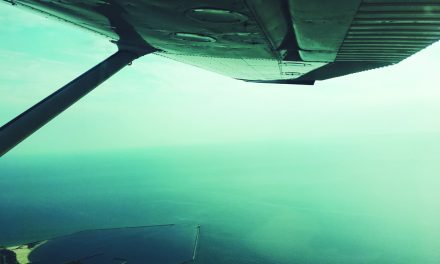Homework in Alaska is Different, and it Teaches Something to Everyone
By Jim Gibertoni
No one ever said, “Hey, I went flying this past weekend and let me tell you all about my preflight inspection.” That’s because it has zero pizazz, and most people treat it like a chore — therein lies the problem. Most pilots sooner or later have an event (small or large) while actually in the air, and that event probably had its roots during preflight. Those experiences have no value unless we can learn from them and pass the knowledge on to other pilots.
Pilot homework
During my younger years up through high school, I always had a ton of homework. I hated it. In my senior year, I asked a teacher why we always had a lot of homework. The teacher told me the primary reason we got homework was not to learn the subject of the homework; rather it was to instill skills for research and practice on how to handle unfamiliar subjects we encounter through life. For example: aviation. I can’t emphasize enough the importance of a thorough preflight. It’s like your homework.
It all starts there: a good pilot needs to hammer it down. It’s got to be ingrained in the pilot. That’s why the military teaches discipline. There’s no place in aviation for “how little can I do?” people. If this is your hobby, ask yourself, “Who cheats at their hobby?”
Every time I have an anomaly while flying, after I land I ask myself, “How could I fix this so as not to repeat it?” Better preflight — boom, done (most of the time). No effort is needed to blame others, I found the crux of the problem … and it is me.
Preflights are a pilot’s homework. I break them down into three categories.
The pilot
Most pilots are familiar with the I’M SAFE acronym, and it works well for me. It’s a great memory checklist (although I am trying to come up with a way to add “B” for bladder). I use this checklist the night before and just before the flight.
I – Illness
M – Medication
S – Stress
A – Alcohol
F – Fatigue
E – Eating
Hot tip here: if you have zero food in your stomach and you have an off-airport landing, and on the ground it’s cold and wet, you will find yourself behind your own power curve when you step out of the plane. Not cool (no pun intended).
As I mentioned in a previous column, I am a Civil Air Patrol mission pilot. Before each flight at CAP, we have to complete an online “risk management” assessment that’s based on points. I actually use it for my own personal flights in my plane, too. It is the best risk management program I have ever used or come across, bar none. It should be disseminated to the public. Do not blow off risk management. Find a program you like and use it. Have a plan for every phase of flight including descent and taxi.
In Alaska there are few refueling facilities, so one needs to be cognizant of this while preflighting. Fuel could be $6 per gallon to $12 per gallon plus a call-out fee. I suggest you call ahead and make sure that village actually has fuel to purchase.
Alaska is no place to blow off NOTAMs — nowhere is. Check not only runway lengths and surface type, but also runway gradient. No one wants to take off downwind with a tailwind on a muddy surface at gross on a warm day.
§ 91.103 Preflight action.
Each pilot in command shall, before beginning a flight, become familiar with all available information concerning that flight. This information must include –
(a) For a flight under IFR or a flight not in the vicinity of an airport, weather reports and forecasts, fuel requirements, alternatives available if the planned flight cannot be completed, and any known traffic delays of which the pilot in command has been advised by ATC;
(b) For any flight, runway lengths at airports of intended use, and the following takeoff and landing distance information.
The machine
I always like doing the machine preflight beforehand because, unlike the environment, it’s not time sensitive. I am lucky I have a heated and secured hangar (in Fairbanks, Alaska). If need be, I can do the aircraft preflight days before. I love going to the hangar, either late at night or early in the morning, and locking the door so I do not get interrupted. Any interrupted preflight could be a flawed preflight.
Preflighting an airplane is checking it out to determine if it will actually fly legally like it’s certified to. I follow three steps for preflighting my airplane.
- Review paperwork: the certificate, current annual, registration, current POH in the aircraft, proper checklists, STCs, and past oil change date.
- Airframe and engine preflight: Use the approved checklist. Check for obvious damage and squawks. Check oil and fuel. Move all the controls. Check the tires — everything rides on your landing gear. Literally.
- Use the approved checklist for that specific airplane.
The environment
Let me give you the big picture here (I love visuals). Imagine you’re sitting midcourt on a top bleacher seat way up high in a full-sized gymnasium (94 feet by 50 feet). A topographical table map of Alaska is taking up most of the gymnasium floor complete with all the significant landmarks. The exits from the gym are on the opposite side; the only way out is over the table in the dark.
Little tiny pin lights light up the communities. From your seat you may need field glasses to view the details properly (they’re so small compared to the size of the map).
Obviously, the 200 bush communities are just very small specs that are difficult to make out — hence the field glasses. Then you notice there are about two dozen chartreuse things that look like sewing thimbles scattered around this big map. In your hand is a legend of this map and on it you see that those are the only (20-plus) true weather stations in Alaska.
Next you notice about 136 magenta things next to the villages. They’re about the size on an upside-down shot glass. They’re ASOS/AWOS located at most village airstrips. Notice I said airstrip not airport. Is there is a difference? You’ll notice it as you’re landing.
The upper limit of cloud height and visibility reported by ASOS/AWOS is 12,000 feet and 10 miles visibility. Ten miles at 120 knots is around five minutes of flight.
Now, to be fair, there are 230 weather cameras throughout the state, too. They’re shown on that map in the gym as bright blue spikes. They are useful to some degree and FSS people love to use them. What they don’t tell you is they’re labeled “supplementary” in nature. As I understand it, that’s a caveat! You can include them in your preflight as supplementary information; however, you’re not to use them within your to-go or not-to-go decision making.
Now, where’s this all going? What is painfully evident while sitting up in that bleacher seat by yourself is the vast distance between weather reporting areas. That distance is humongous! I am here to tell you when you’re flying between those areas you get that same feeling of being by yourself as you would sitting in that gymnasium by yourself. You’re in the Alaskan abyss by yourself. I’ve had my moments up there. Complaining, screaming, and pounding on the glareshield don’t work, and praying seems to have no effect.
So, at FSS they give me a weather briefing and they drag out the area forecast and it has an AIRMET for high winds, shear, and turbulence along my route and, yes, the old faithful “mountain obscuration” (which is as common as saying hello).
Understand, there’s no weather reporting and no weatherman on site in the bush. We just have PIREPs along this route. So, how did they come up with this AIRMET? Well, their weather computer spit out that info based on the overall input they received from hundreds of miles away. It’s a weather model, which is the nice way of saying it’s a well-researched, best educated guess by our best weather people. While a model is sometimes correct (to a degree) it’s not gospel, and therein lies the problem.
Models are used all over the vast oceans of the world. Without them we got zip! Sometimes-correct models are better than zip. I don’t know how many times I have been over the Alaskan Range and called for an update. Boom — I get an AIRMET for mountain obscuration. I respond that I am at 8,000 feet and I can see 60 nautical miles plus in every direct with no mountain obscurations. I ask for a vector to it so I can photo it. The response is “VNR” (VFR not recommended). I really appreciate that recommendation from a newbie specialist who’s been in Alaska for six months based on an AIRMET, which was based on a weather model from a weather station many miles away.
Honestly, do not ever discount a weather forecast or the associated AIRMETs. I don’t. But VNR needs to go away. At best it’s ancestral worship and, in my humble opinion, it’s either ignored or it irritates pilots.
As I said previously, I use a risk management program. I take into consideration all information and I assign a value number to it. This is done to get a more accurate, weighted return on the incoming information. When an FSS specialist briefer tells me to beware mountain obscurations while I can look out my airplane window and see 60 nautical miles in all directions without any obscurations whatsoever, I tend not to give that report much weight (maybe one grain of salt). However, when I hear that I go back and do more homework, especially looking for PIREPs.
What I have learned in life is you just cannot throw stones at easy targets like weather models — a lot of effort goes into them. I have been told that NextGen, ADS-B, tablets, and ForeFlight have done a remarkable job of bringing current weather reports inside cockpits in the lower 48. However, in Alaska that simply is not true. We simply don’t have the infrastructure. Given Alaska’s size that’s never going to happen, it’s not reasonable nor logical.
Final thoughts
Last but not least, do your weight and balance with much diligence. Strive to get the CG in the middle of the envelope (or the sweet spot). Please do not go near turbulence while on the edge of the envelope. The pilot needs to do the correct thing when no one’s looking.
Jim Gibertoni has been a pilot in Alaska for more than 40 years. He has flown as a search and rescue pilot for 23 years and currently owns a Cessna U206G, which he uses to give the occasional ride to Alaska newbies.






